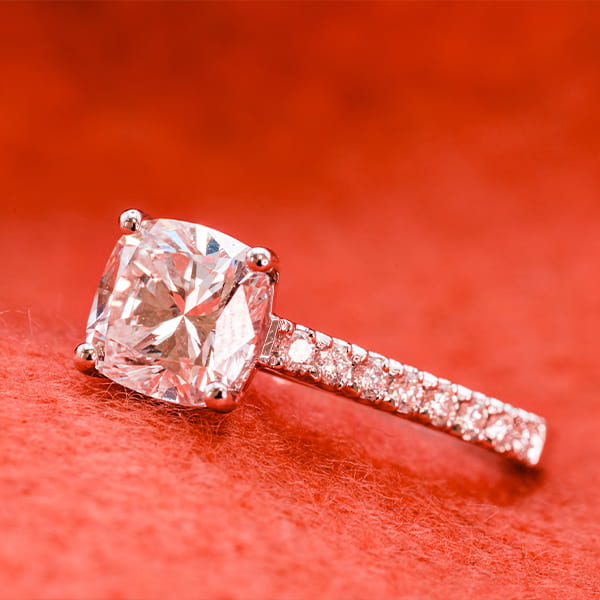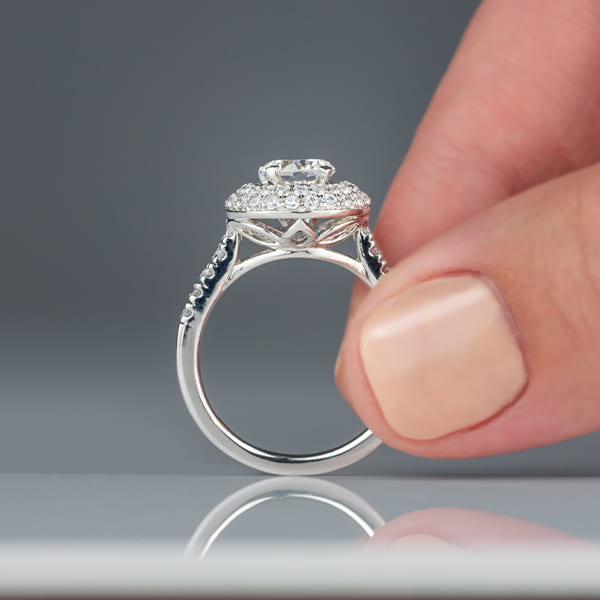Embarking on the journey to find the perfect diamond engagement ring is like navigating a sea of sparkling possibilities. This comprehensive guide is your compass, leading you through the intricate world of diamond quality, styles, and designs. At its core, the understanding of the Four Cs – Cut, Colour, Clarity, and Carat – shapes the essence of your ring’s charm and value. Whether you’re drawn to the timeless elegance of a round brilliant cut or the unique charm of a marquise setting, this guide promises to illuminate every facet of your quest. With expert insights and tips, prepare to discover an engagement ring that captures the light and encapsulates the depth of your love story.
Understanding the Four Cs of Diamond Quality
Selecting the perfect engagement ring is akin to crafting a masterpiece; it’s about finding harmony between various elements to create something truly remarkable. At the heart of this process lies the understanding of the Four Cs – Cut, Colour, Clarity, and Carat. Each of these aspects plays a crucial role in determining the overall allure and value of a diamond.
The cut of a diamond is not just about its shape; it’s a testament to the stone’s symmetry, proportions, and polish. This intricate dance of angles and finishes is what breathes life into the diamond, coaxing out its inner brilliance and fire. The round brilliant cut, for example, with its 58 facets, is celebrated for its exceptional ability to capture light, making it a perennial favourite among brides-to-be.
Moving on to colour, this characteristic is all about the absence of colour. The most prized diamonds are those that are colourless, allowing them to refract light in a spectrum of dazzling hues. Each diamond is graded on a scale from D (colourless) to Z (light yellow or brown), and this gradation can significantly influence the stone’s value.
Clarity refers to the absence of inclusions and blemishes. These tiny natural imperfections can detract from a diamond’s beauty and are assessed under 10x magnification. A diamond’s clarity is a whisper of its journey from deep within the Earth, and finding one that balances purity with character can be a deeply personal choice.
Lastly, carat weight measures a diamond’s size. It’s a common misconception that bigger always equates to better. However, a well-cut, smaller diamond can often outshine a larger stone of inferior quality.
Fun Fact: Did you know that the word ‘carat’ is derived from the ‘carob’ seeds, once used as a standard to balance scales in ancient times?
Exploring Popular Diamond Cuts for Engagement Rings
The shape of a diamond is not merely a matter of aesthetics; it’s a reflection of an individual’s personality and style. Each cut tells a different story, from the classic round brilliant diamonds to the more avant-garde marquise diamond settings.
The princess cut offers a modern yet sophisticated choice for those seeking timeless elegance. Its sharp angles and clean lines are particularly fetching in solitaire rose gold rings. On the other hand, the emerald cut is a nod to vintage glamour, often found in art deco engagement rings. Its elongated form and step-cut facets create a hall-of-mirrors effect, exuding understated sophistication.
The romantic and antique cushion cut combines a square cut with rounded corners, resembling a pillow – hence its name. It’s a stunning choice for those who yearn for a touch of the old world in their engagement ring, often set beautifully in halo engagement rings.
For lovers of unique designs, the pear shaped diamonds, resembling a teardrop, offer a blend of the marquise and oval cuts. This distinctive shape is both bold and delicate, perfect for a ring that stands out from the crowd.
Comparing Earth Mined and Lab-Grown Diamonds
The choice between earth-mined and lab-grown diamonds becomes significant in today’s world, where ethical considerations and sustainability take centre stage. Both share identical physical and chemical properties, yet they diverge in their journey to the jeweller’s display.
Earth-mined diamonds are treasures of nature, formed over billions of years under extreme pressure and heat deep within the Earth’s crust. They carry with them a legacy of rarity and tradition. However, this tradition often comes with a higher price tag and concerns over environmental and ethical sourcing.
Conversely, lab-grown diamonds, as their name suggests, are cultivated in controlled laboratory environments. They offer a more affordable and ethical alternative to their natural counterparts without compromising beauty or quality. The rise in their popularity is a testament to a shifting paradigm in the jewellery world, where modern technology meets age-old desires.


Selecting the Right Precious Metal for Your Ring
The choice of metal for an engagement ring is as crucial as the diamond it cradles. This decision affects the ring’s overall look and its durability and maintenance over time.
Platinum, with its silvery-white sheen, is a popular choice for its durability and hypoallergenic properties. It’s a fitting canvas for GIA-certified diamonds, highlighting their brilliance. White gold, an alloy of gold and white metals like nickel, offers a more budget-friendly alternative to platinum while maintaining a similar appearance.
For those drawn to warmer hues, yellow gold is a timeless choice, imparting a classic and traditional look to the ring. It pairs splendidly with vintage styles and adds a rich warmth to the stone’s appearance. Rose gold, on the other hand, has risen in popularity for its unique pinkish hue. It offers a modern twist and is often chosen for its romantic and distinctive look, perfect for settings like eternity rings rose gold.
Choosing the metal for your ring is like selecting the perfect frame for a masterpiece painting. The frame should complement and enhance the artwork, just as the metal should accentuate the beauty of the diamond.
Balancing Beauty and Budget: The Cost of Engagement Rings
When it comes to engagement rings, the question of cost is often front and centre. How much should one spend on this significant piece of jewellery? The truth is, there’s no one-size-fits-all answer. It’s about striking a balance between your dream design and what you’re comfortable spending.
The price of an engagement ring can vary widely, influenced by factors like the quality and size of the diamond, the intricacy of the setting, and the type of metal used. For instance, a simple solitaire rose gold ring might be more budget-friendly than a platinum and diamond band with intricate pave diamond bands.
An interesting approach to consider is the ‘two months’ salary’ rule, a guideline suggesting that an engagement ring should cost the equivalent of two months of your income. However, this is merely a guideline, not a strict rule. The focus should be on finding a ring that resonates with your partner’s style and your financial situation.
Bespoke Design vs Ready-Made Rings: What Suits You Best?
In the quest for the perfect engagement ring, one often faces the choice between bespoke designs and ready-made rings. Bespoke or custom engagement rings, offer a level of personalisation and uniqueness unmatched by off-the-shelf options. They allow you to be involved in every step of the creation process, from selecting the diamond, like a princess cut diamond, to choosing the setting, such as a bezel set ring.
Ready-made rings, on the other hand, are great for those who prefer a more straightforward shopping experience. These rings are readily available in a variety of styles, from vintage engagement jewellery to contemporary three-stone engagement rings. They’re perfect for those who want to make a quick decision without compromising on beauty or quality.
Where to Buy the Best Engagement Rings?
London’s Hatton Garden stands out in the quest for the ultimate engagement ring, especially the high-end boutique Smith & Green Jewellers. Esteemed as the premier destination for the most extraordinary engagement rings in the UK, a visit to their store guarantees an encounter with an unparalleled collection. From heart-shaped diamonds to ethereal eternity rings in rose gold, their range is a testament to luxury and craftsmanship. What truly sets Smith & Green apart is their bespoke design service. Suppose your dream ring isn’t on display. In that case, their skilled artisans are adept at bringing any imagined design to life, crafting unique engagement rings tailored to individual desires. This remarkable service, combined with their exquisite collection, makes Smith & Green Jewellers the quintessential choice for those seeking a ring as unique as their love story.
Conclusion
Choosing the perfect diamond engagement ring is a journey filled with decisions, from understanding the nuances of the Four Cs to selecting the right precious metal and balancing beauty with budget. Whether you opt for a bespoke design or a ready-made ring, the ultimate goal is to find a piece that symbolises your unique love story. Remember, an engagement ring is not just a piece of jewellery; it’s a testament to your commitment and the start of a new chapter together.
FAQs
- Q: What’s the most important of the Four Cs? A: The cut is crucial as it determines the diamond’s brilliance.
- Q: Is platinum better than gold for rings? A: Platinum is more durable but also pricier than gold.
- Q: Can I tell if a diamond is lab-grown? A: Lab-grown diamonds are indistinguishable without special equipment.
- Q: How much should I spend on an engagement ring? A: Spend what feels right; there’s no fixed amount.
- Q: Are bespoke rings more expensive? A: Bespoke rings can be pricier due to customisation.

















